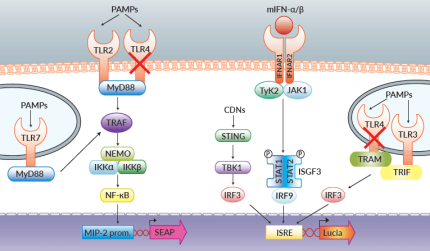RAW-Dual™ KO-TLR4 Cells
-
Cat.code:
rawd-kotlr4
- Documents
ABOUT
TLR4 knockout IRF-Lucia & MIP-2-knockin-SEAP murine macrophage reporter cell line
RAW-Dual™ KO-TLR4 (IRF-Lucia/KI-[MIP-2]SEAP) cells were generated from RAW-Dual™ cells through stable gene knockout of mouse Toll‑like receptor 4 (TLR4). These cells derive from RAW 264.7 murine macrophages, which express many pattern recognition receptors (PRRs) [1].
RAW‑Dual™ KO-TLR4, along with their parental cell line RAW-Dual™ cells, can be used to:
- Investigate TLR4 signaling
- Study TLR4-independent biological activity of test compounds.
Both cell lines stably express two reporter genes encoding SEAP (secreted embryonic alkaline phosphatase) and Lucia® luciferase.
- SEAP expression depends on the activation of the endogenous MIP-2 promoter. MIP‑2 is a chemokine produced in an NF-κB-dependent manner [2]. The MIP-2 ORF has been replaced by the SEAP ORF using knock-in technology. Hence, SEAP expression reports activation of NF-κB.
- The Lucia luciferase gene is under the control of an ISG54 minimal promoter in conjunction with five IFN-stimulated response elements (ISRE). It reports the activation of interferon regulatory factors (IRFs).
- Both reporter proteins are secreted and readily measurable in the cell culture supernatant using QUANTI-Blue™ Solution, a SEAP detection reagent, and QUANTI‑Luc™ 4 Lucia/Gaussia, a Lucia and Gaussia detection reagent. Alternatively, SEAP activity can be detected using HEK-Blue™ Detection, a cell culture medium allowing real-time detection of SEAP.
As a result, RAW-Dual™ KO-TLR4 cells allow to simultaneously study the NF-κB pathway, by assessing the activity of SEAP, and the IRF pathway, by monitoring the activity of Lucia luciferase.
As expected, RAW-Dual™ KO-TLR4 cells do not respond to TLR4 agonists such as whole lipopolysaccharide (LPS) or monophosphoryl lipid A (MLPA) (see figure).
References:
1. West A. et al., 2011.TLR signalling augments macrophage bactericidal activity through mitochondrial ROS. Nature 472:476-80.
2. Kim D. et al., 2003. NF-kappaB and c-Jun-dependent regulation of macrophage inflammatory protein-2 gene expression in response to lipopolysaccharide in RAW 264.7 cells. Mol Immunol. 40:633-43.
Disclaimer: These cells are for internal research use only and are covered by a Limited Use License (See Terms and Conditions). Additional rights may be available.
SPECIFICATIONS
Specifications
TLR4
Mouse
Screening of PRR agonists or inhibitors
Complete DMEM (see TDS)
Verified using Plasmotest™
Each lot is functionally tested and validated.
CONTENTS
Contents
-
Product:RAW-Dual™ KO-TLR4 Cells
-
Cat code:rawd-kotlr4
-
Quantity:3-7 x 10^6 cells
- 1 ml of Zeocin® (100 mg/ml)
- 1 ml of Normocin™ (50 mg/ml)
- 1 ml of QB reagent and 1 ml of QB buffer (sufficient to prepare 100 ml of QUANTI-Blue™ Solution)
- 1 tube of QUANTI-Luc™ 4 Reagent (sufficient to prepare 25 ml)
Shipping & Storage
- Shipping method: Dry ice
- Liquid nitrogen vapor
- Upon receipt, store immediately in liquid nitrogen vapor. Do not store cell vials at -80°C.
Storage:
Caution:
Details
Toll‑like receptor 4 (TLR4) is the receptor for Gram-negative lipopolysaccharide (LPS) and its toxic moiety called lipid A. TLR4 interacts with three different extracellular proteins: the LPS-binding protein (LBP), CD14, and the myeloid differentiation protein 2 (MD‑2). Their interaction induces a signaling cascade resulting in the activation of NF-κB and the production of proinflammatory cytokines. LPS contamination is a common issue arising when testing novel compounds, such as recombinant proteins, leading to unreliable results. TLR4 knockout cells ensure the study of PRR pathways without interference from LPS.
DOCUMENTS
Documents
Technical Data Sheet
Validation Data Sheet
Safety Data Sheet
Certificate of analysis
Need a CoA ?










